-
Posts
5,629 -
Joined
-
Last visited
Content Type
Profiles
Forums
Blogs
Gallery
Events
Store
Posts posted by IrishGunner
-
-
Rick,
Actually, I do have a complete list.

There was no white 75th foot artillery strap. One would only expect to see the prewar numbers on a Dunkelblau tunic. Perhaps when you show the photo a better assessment can be made.
Chip
Chip; because of the paper the photo is printed upon, getting a good digital image is difficult. (Yes, I know Rick Research - Epson
 )
)But... I have found that the Infantrie Regiment Nr. 75 is from Bremen. And the postcard was printed in Bremen. I am 100 percent positive of the light colored shoulder strap with only a 75 on it. I have seen one image that has the Inf. Regt. Nr. 75 with a yellow shoulder strap on the Dunkelblau.
I'll post the image over in the Photographs section to start a new discussion...if necessary. :cool:
0 -
I believe that this has the Honour Medal "To Merit" for the Municipal Police and Fire defence Service of the town of Barcelona. The regulations are of 1976 but this coat of arms ob the reverse are for the type since 1981. The obverse wear the coat of arms of the town of Barcelona
Is awarded for relevant services in their proffessional activities
This Honour Medal if in two classes:
- "To Suffering"
- "To Merit"
And each class three types: gold, silver and bronze (for facts of relevant and public transcendence or 25 years LS&GC)
Antonio - thanks for the details! I knew you would be the one with the answer.

I actually checked your website first, but didn't see this medal.
0 -
I'm not positive but I'm thinking a modern Spanish award. The rectangular metal piece on the top of the ribbon is the same was what the Spanish use on their medals. Also on the coat of arms in the first picture... I believe that's the pillars of Hercules used on alot of Spanish coins, medals, etc. Also the quartering on the arms... the castle and the lion... Castile and Leon. Although on the ones I'm familiar with on Reale coins and such there are generally two quarters with the castle and two with the lion opposite diagonally to each other.
Anyhow hope this helps somewhat.

Dan

Dan, this does help somewhat. Your focus on the coat of arms got me to thinking; so, I went looking for the coat of arms of Catalunya and Barcelona. The coat/arms on the front is certainly for Spain. But the one on the back, is for the city of Barcelona - where the medal was found! Possibly a civil award from the city of Barcelona. This actually makes it even cooler as a gift from my son!
http://www.ngw.nl/int/spa/b/barcelon.htm
Cheers! :beer:
0 -
Not the best quality, but my tools aren't the best either...
The EK2 entry...
 0
0 -
Nice! Lets see some pics of the book!
Not the best quality, but my tools aren't the best either...
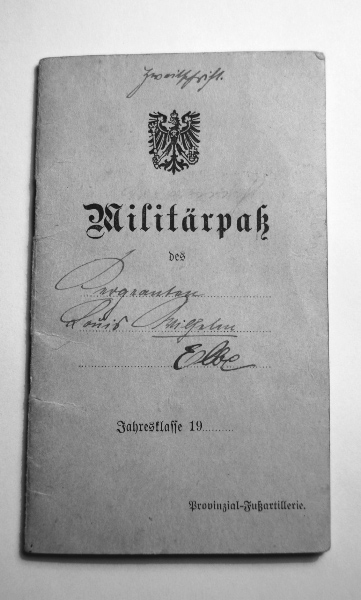 0
0 -
The reverse:
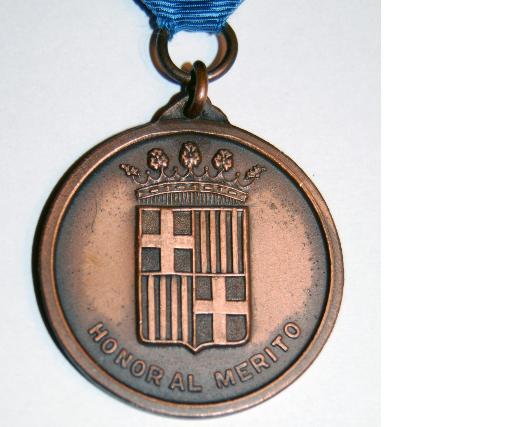 0
0 -
My son bought this at a flea market in Barcelona during a family a trip awhile ago; he gave it to me this year for Christmas (really cool that he notices my hobby!) He also gave me a Spanish Civil War Victory and Rising Medal. That one was easy to identify; this one I can't find anywhere online.
The front:
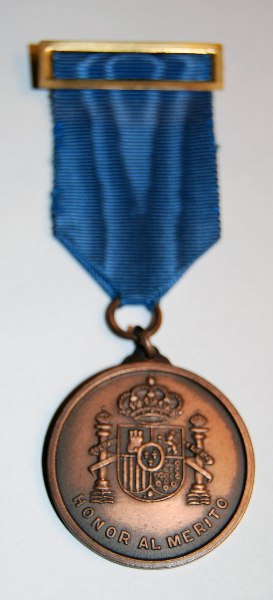 0
0 -
First came the easiest of the 3 - the 1870 medal, then the Saxe-Altenburg medal....and just last week from Christian (thanks mate!) came the 1870 EK2.
So here is is, back to its original form:
Great project! Nice bar.

Well done.
0 -
I am constantly amazed how heavily the German Army was dependent on horses.
Hollywood never shows it this way...
0 -
Rick,
Actually, I do have a complete list.

There was no white 75th foot artillery strap. One would only expect to see the prewar numbers on a Dunkelblau tunic. Perhaps when you show the photo a better assessment can be made.
Chip
Will you share the list?

No 75 foot?
 Ok, will post as soon as I can... (Which means getting photographer wifey to help.)0
Ok, will post as soon as I can... (Which means getting photographer wifey to help.)0 -
Rick,
According to my reference, there was no artillery unit with the number 934. As mentioned, there were 900 series field artillery units, but only a relatively small number. Not anywhere near all of the series numbers were used. On the other hand, the munitions columns were numbered consecutively 900-999.
Chip
So, you wouldn't happen to have a list of all artillery units would you? I mean including reserve, independent battalions, independent batteries, etc, etc, etc? Each and every one?

Just kidding...
 But I sure could use one of those...
But I sure could use one of those...Actually, I just received a post card of a group of new kanonieren - all dressed in Dunkelblau with what appear to be white shoulder straps - can make a 75 one one strap. I know there was a Fussartillerie Battalion 75; could this be it? (Will try to post photo this weekend after a trip to Krakow.)
0 -
A little over a month ago, I obtained the militärpass of Sergeant Louis Elbe of the Masurisches Fuss-Artillerie Regiment Nr. 22. Twice promoted and recipient of the EK2 in 1917, this was a grizzled veteran who fought from almost the first day of the war until the last - on both fronts.
Here's his story that I've determined from his militärpass and a bit of other research. Unfortunately, I didn't find much on Fuss-Artl. Regt Nr. 22; however, Sergeant Elbe's story reads like a mini-history of at least part of the Regiment.
--------------------------------------------------
Coming from Hildesheim in Hanover, twenty-year old Louis Elbe entered military service on 14 October 1898 as a recruit with the 2. Badisches Feld-Artillerie-Regiment Nr.30, 8. Batterie; garrisoned in Rastaat, Baden. He spent two years with the Regiment, being promoted to Gefreiter in April 1900 and transferring to the Reserves in October of that same year. With the outbreak of WWI, Gefreiter Elbe was mobilized with Ersatz Munitions Kolonne 44. and immediately went to the front in Lothringen (Lorraine). He would see further battle during most of 1914 on the Western Front, including at Arras in October 1914.
Sometime in the middle of December 1914, his unit transferred to the Eastern Front, arriving in the region along the Bzura and Rawka rivers in Central Poland, probably joining the IX. Armee. According to the chronicle of the IX. Armee, heavy artillery from the vicinity of Lille and Metz, from the 4. and 5. Armee, moved by rail and off-loaded in the region west of Warsaw. Elbe was with his unit in this region on 31 January when the Germans attempted the first large-scale use of poison gas at the Battle of Bolimów west of Warsaw, Poland. Elbe participated in several battles on the Eastern Front, including the Battle of Lemberg (Lwów in current day Ukraine), during 1915 before returning at some point late in the year or early 1916 to the Western Front.
On 10 March 1916, Elbe joined a munitions column in the newly formed Masurisches Fuss-Artillerie Regiment Nr. 22. Beginning with the Battle of Verdun in April 1916, Elbe participated in battles from the Somme to trench warfare on the Siegfriedfront to Flanders and culminating with the fighting at St. Mihiel before Germany surrended in November 1918. A grizzled veteran, Gefreiter Elbe was promoted to Unteroffizier for bravery in the face of the enemy on 23 May 1917 and later that year on 19 Dec 1917, he was awarded the Eisenes Kreuz II. Klasse. On 23 January 1918, Elbe was promoted to Sergeant. By the war's end, Sergeant Elbe had seen combat from shortly after the guns of August opened fire in 1914 until the guns fell silent on 11 November 1918. Fuss-Artillerie Regiment Nr. 22 mustered out one of its finest on 21 November 1918. Four days later, he boarded a train to reunite with his wife and seven children, who at some point had moved to Langenfeld in the Rheinland.0 -
PS
Afterthought-- wading through the Sachsen-Meiningen WW1 enlisted award rolls now, Fußa 18 and all its war spinoffs were heavily decorated/staffed from that Duchy-- too bad no NAME on your photo!
Rick; thanks for your reply. So, it's a bit impossible to narrow the date of the photo - our good gefreiter could have pulled out the blau for his wedding since it probably was more "elegant."
Yes; too bad about the lack of name. One of these days I hope to benefit from your identification wizardry! :catjava:
0 -
Ok, it is clear that the 1895 Dunkelblau waffenrock was officially replaced by the Feldgrau Model 1910. However, how long after 1910 were Dunkelblau waffenrock allowed to be worn?
I am trying to roughly date a photo; the soldier is wearing a Dunkelblau and has the EK2 showing. So, on one end is Aug 1914; but what date might be on the other end?
Here is the Fuss-Artl. Regt. Nr. 18 kanonier in his Dunkelblau:
http://gmic.co.uk/index.php?showtopic=34008&st=0&p=319450&fromsearch=1&#entry319450
0 -
There were a few 900 series FARs, but this unit is most likely one of the 900 series munitions columns. They also wore normal looking FAR shoulder straps. FAR straps were numbered well into the 1000 series.
Chip
Chip,
Why do you say this is a munitions column unit? Too high to be a 900-series FAR?
0 -
Rick;
Way off, I am sad to report. It seems that he received 65 Marks, probably marching-out money. Nothing there to say he was in the Reichswehr, unless I missed something. It seems to be the usual amount that men got when pushed out the door in 1918 or 1919. Certainly not a unit designation. Don't feel bad, I have done these for years, still not good. The story of what I thought my father's Pass said the first time I tried is hilarious, but a bit too long to recount now. These things have patterns and when you get to do a number they fall into a pattern.
I have a great artillery Pass, guy had a rich combat history in the war, then shuffled into a Freikorps, and then into the Reichswehr, all in one document.
Bob
Hey, I feel great!
 This is my first Pass translation and this seems to be my only huge error.
This is my first Pass translation and this seems to be my only huge error. 
I'm glad I posted it because now I've learned something about marching out money - something I didn't know about. Next time I see something similar - I will be smarter.:catjava:
0 -
Now this is the really difficult one. This one seems to tell what unit Steinkemper was assigned to in 1919.
Hxx 165. Batl. Artl. xxx Batl. xxxx xxxxx X. 13.4.20
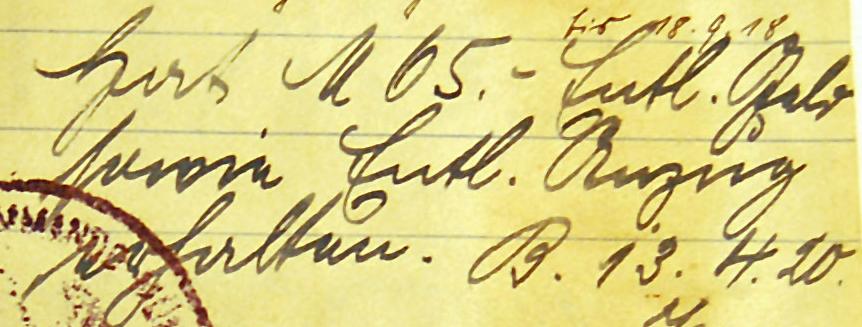 0
0 -
This hard to read stempl looks like "Kommando Muenster" - Muenster is the district city for Beckum (Steinkemper's town) in Westphalia.
Is Bezkdo XXX somehow related to Muenster?
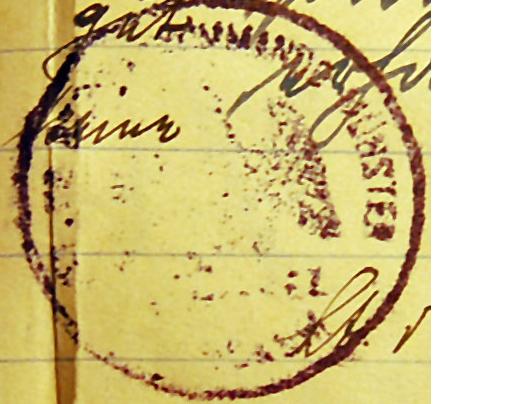 0
0 -
Uwe, vielen dank! Fantastisch!
Only two more pieces to the puzzle. From these excerpts, it appears that Kanonier Steinkemper did some kind of service in the Reichswehr, 29.4.19 to 13.4.20
In this piece he receives a coat, pants, and boots from what seems to be Bekdo. XXX for the year.
Hxx beim Bezkdo XXX Rock, Hose, Stiefel xxxxx vom 29.4.19 X 13.4.20
 0
0 -
Rick;
I think I sent you my e-mail.
You did. And I just sent an email to you.
0 -
Bob,
Indeed, comparing letters to other already deciphered words is a great hint.
I was pretty sure the abbreviation was "bayr." for bayerische - Bavarian - as you suggest. But it was exactly the same word that stumped you that has given me the most trouble. In other entries, I can figure out context, but this one has me totally perplexed.
Now that my eyes are rested, I will go attack it once more.
PS: We may want to conspire about my grand-father, who started out as a Prussian heavy artillery NCO, probably in III. Armeekorps. In a few days I am getting an important and quite rare book about the Prussian artillery, only about four copies cataloged in the US, 1510 pages of good stuff. He wrote an article in it.
1500+ pages on the Prussian artillery!
 Where is the envious drooling smiley face icon? Four copies?
Where is the envious drooling smiley face icon? Four copies? 
Happy to help with your grand-father in any way I can... :beer:
0 -
Hi,
I think it's "Augen (eyes) Krank".
Best regards,
Stephan
Quite possible; now with your suggestion - and Bob's hint - I will compare to other words that I know have the same letters.
0 -
Hello,
here we have a certificate to another commander of the Fußartillerie-Regiment Nr. 1
His name was Martin Julius Gerhard Kadelbach!
Do you have some more informations about the regiment between March and July 1918???
There you have also a face of him

Best wishes
Karsten
Karsten; thanks! These are great additions to the thread. I appreciate the photo and document. Hopefully, I will be able to add such items to my collection.
Unfortunately, I do not have more info on the regiment. I am searching out info on other regiments and am always on the look-out for more history and will keep you in mind for this period. Maybe I will one day be able to snag a regimental history.
0 -
Rick;
In post # 5 you only identified a few officers of the regiment. Am I missing something, or do you have access to Prussian Ranglisten? The 1914 issue had the entire officer corps of the regiment as of May 6, 1914, their seniority, posts within the regiment, decorations, usw. I have about 30 or so Prussian Ranglisten for many dates from 1879 to the 1926 Ehrenrangliste covering 1914-1918, so let me know if you don't have access to this info. (Or did I just fly to an incorrect conclusion?)
Bob Lembke
Bob, these officers were gleaned from the internet. I do not have any Ranglisten.
I am just starting these regimental histories; based upon what I can easily find. Certainly, there is more info out there; I am just not sure where I should draw the line. At some point in the future, I may start a website representing all regiments of the German Imperial artillery. I just am not sure what I would want each page to look like. At this point, I am just fascinated by whatever I can find...
0




Infanterie-Regiment Bremen (1. Hanseatisches) Nr.75
in Germany: Imperial: Rick (Research) Lundstrom Forum for Documentation and Photographs
Posted · Edited by IrishGunner
Live and learn or better yet - get advice from GMIC!
I bought this thinking it was a photo of Fuss-Artillerie kanonieren. However, GMIC'er and resident Imperial artillery expert Chip advised that there was no Fuss-Artillerie Nr. 75; so, who are these guys?
Doing a bit more digging on my own, I found that Infantrie Regiment Nr. 75 was from Bremen. This postcard was printed in Bremen (no other writing on back and not postally used).
The soldier front row, third from right clearly has "75" on his shoulder straps; I can see this with a magnifying lens. (I know it can't be seen from this poor digital image - Yes, Rick Research I hear you...Epson. )
)
I have seen read that the shoulder strap for Inf-Regt Nr. 75 on a Dunkelblau should be "white with a red 75."
So... Could this be Infantrie-Regt. Bremen (1. Hanseatisches) Nr. 75? And wasn't this the only infantry regiment from Bremen?
So much to learn.... :blush: